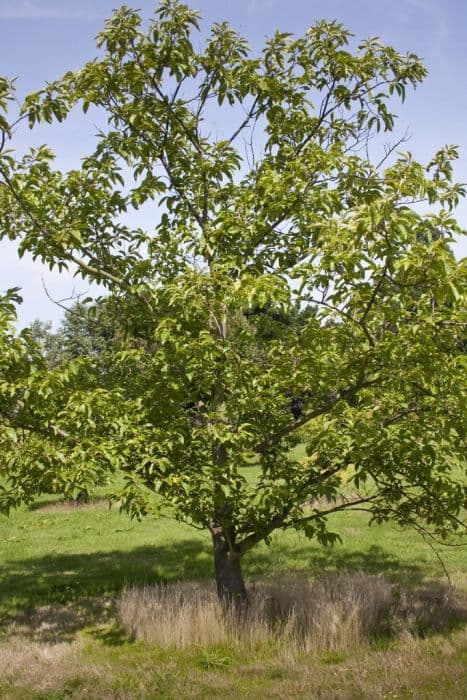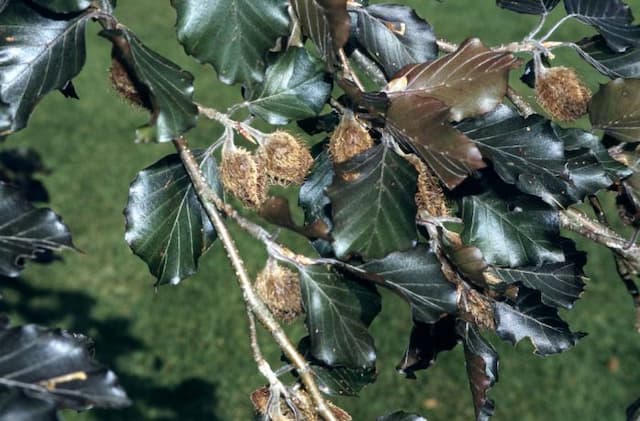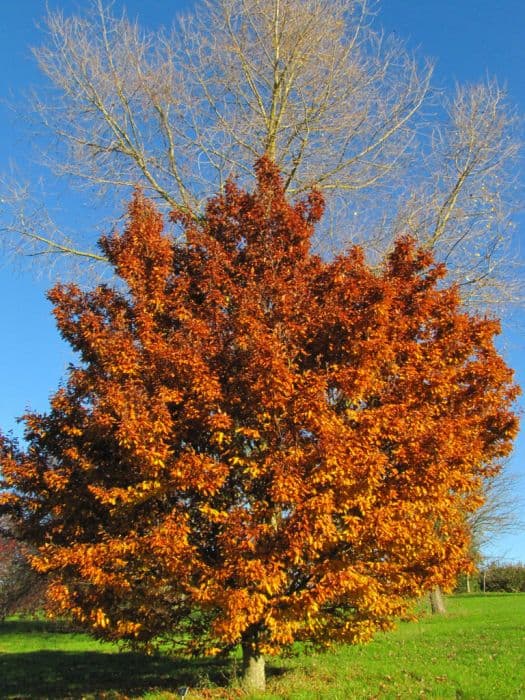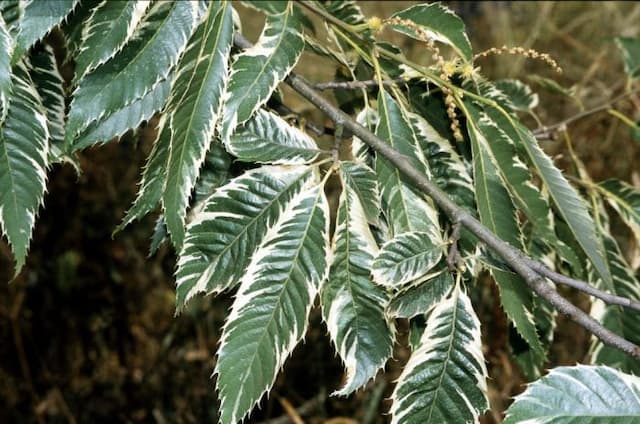Daimyo oak Quercus dentata 'Pinnatifida'

ABOUT
The plant commonly known as the Daimyo oak or the Japanese emperor oak is a striking deciduous tree that boasts a unique and ornamental foliage. The leaves of this tree are quite unusual for an oak, as they are deeply lobed with each lobe being long and narrow, creating a feathery or fern-like appearance. The overall shape of the leaf is somewhat elongated with a pointed tip, and the edges are serrated or toothed, giving the plant its name. During spring and summer, the leaves display a fresh and vibrant green color that catches the eye. As the seasons change into autumn, the foliage of the Daimyo oak transitions to splendid shades of gold, bronze, or reddish-brown, creating a warm, colorful display in the landscape before the leaves eventually fall. The tree also produces characteristic acorns, which are the fruit of the oak. These acorns tend to be broad and squat with a tough outer shell and a textured, cap-like covering on top that adds to the plant's ornamental value. The bark of the tree is another point of interest, being rough and textured, which becomes more pronounced as the tree ages. This bark adds a certain rugged charm and provides year-round interest even when the tree is without leaves.
About this plant
 Names
NamesFamily
Fagaceae
Synonyms
Daimyo Oak, Cutleaf Japanese Emperor Oak
Common names
Quercus dentata 'Pinnatifida'.
 Toxicity
ToxicityTo humans
The common name for Quercus dentata 'Pinnatifida' is Daimyo Oak. Generally, the Daimyo Oak is not considered toxic to humans. However, like other oaks, the acorns and leaves might contain tannins which can cause stomach upset, kidney damage, and liver damage when consumed in large quantities. Symptoms can include nausea, vomiting, diarrhea, abdominal pain, and lethargy. Eating small quantities is unlikely to be harmful, but consuming large amounts of the acorns or leaves, particularly if they are raw, can be dangerous.
To pets
Daimyo Oak can be toxic to pets if they consume a significant amount of the acorns or leaves. The main concern with oak toxicity in pets is the presence of tannins, which can cause gastrointestinal upset and potentially lead to more serious conditions such as kidney damage or liver failure. Symptoms of oak poisoning in pets include vomiting, diarrhea, abdominal pain, and lethargy. In severe cases, there may also be signs of kidney failure, such as increased thirst and urination. If a pet consumes Daimyo Oak leaves or acorns, it is important to seek veterinary care.
 Characteristics
CharacteristicsLife cycle
Perennials
Foliage type
Deciduous
Color of leaves
Green
Height
20-40 feet (6-12 meters)
Spread
20-40 feet (6-12 meters)
Plant type
Tree
Hardiness zones
Varies
Native area
Asia
Benefits
 General Benefits
General Benefits- Aesthetic Appeal: Quercus dentata 'Pinnatifida', commonly known as the Daimyo oak, has distinctive pinnatifid leaves which add unique texture and visual interest to landscapes.
- Shade Provision: The Daimyo oak can grow to a large size, providing ample shade in parks, gardens, and other outdoor spaces.
- Erosion Control: With its robust root system, the Daimyo oak helps stabilize the soil and prevent erosion.
- Habitat Support: The tree offers habitat and food for various species of wildlife, such as birds and insects.
- Longevity: As with many oak species, the Daimyo oak is known for its longevity and can be a long-term feature in a landscape.
- Seasonal Interest: It provides year-round interest with foliage changing colors in the fall and persistent leaves in certain climates.
- Drought Resistance: Once established, the Daimyo oak is relatively drought-tolerant, requiring minimal supplemental watering.
 Medical Properties
Medical PropertiesThis plant is not used for medical purposes.
 Air-purifying Qualities
Air-purifying QualitiesThis plant is not specifically known for air purifying qualities.
 Other Uses
Other Uses- Woodworking: The wood of the Daimyo oak can be used for decorative veneer, paneling, and cabinetry, providing a distinct appearance due to its grain patterns.
- Tanning: The bark contains tannins that can be used for tanning hides and leather in traditional crafts.
- Forest restoration: The acorns can be used to regrow forests in areas suffering from deforestation, helping to restore native ecosystems.
- Flour substitute: In times of scarcity, acorns can be processed to remove tannins and ground into flour for cooking and baking.
- Landscape design: Due to its unique leaf shapes, this oak species can be used in landscape designs to create visually appealing patterns and focal points in public parks and gardens.
- Wildlife habitat: The Daimyo oak provides valuable habitat and food for wildlife, including birds and small mammals, which use the tree for nesting and foraging.
- Dye production: The bark and leaves can be used to produce natural dyes for textiles and crafts, offering a range of colors depending on processing methods.
- Livestock feed: The acorns, when properly treated to reduce tannin content, can be used to supplement livestock feed, especially for pigs.
- Wood fuel: The wood from Daimyo oak can be used as firewood after proper seasoning, providing a renewable source of energy for heating and cooking in rural areas.
- Soil improvement: The leaves of the Daimyo oak can be composted and used to improve soil structure and fertility in garden beds and agricultural fields.
Interesting Facts
 Feng Shui
Feng ShuiThe Daimyo oak is not used in Feng Shui practice.
 Zodiac Sign Compitability
Zodiac Sign CompitabilityThe Daimyo oak is not used in astrology practice.
 Plant Symbolism
Plant Symbolism- Strength and Endurance: As a member of the oak family, the Daimyo Oak is often associated with strength due to its robust and sturdy nature.
- Wisdom: Owing to their longevity, oaks are symbols of wisdom, representing the knowledge accumulated over a long life.
- Resilience: The oak's ability to withstand harsh conditions and remain standing is indicative of resilience and the ability to weather life's challenges.
- Nobility: Historically, the oak has been considered a noble tree, often associated with royalty and used in heraldic symbols.
- Hospitality: In certain cultures, the oak is seen as a welcoming symbol, representing hospitality and generosity due to its expansive canopy.
 Water
WaterThe Daimyo oak, commonly known as Quercus dentata 'Pinnatifida', should be watered deeply, ensuring that the water reaches the tree's widespread roots. It's best to water this oak sparingly, as it prefers well-drained soil and does not tolerate standing water. During the growing season in spring and summer, water the tree once a week with about 1 to 1.5 gallons of water, assuming there is no significant rainfall. In fall, reduce watering frequency as the tree prepares for dormancy. If the tree is established and there's average rainfall, supplemental watering might only be necessary during prolonged dry spells.
 Light
LightDaimyo oak thrives in full sunlight, so it is best to plant Quercus dentata 'Pinnatifida' in a spot where it will receive at least six to eight hours of direct sunlight each day. It can tolerate partial shade, but its growth might be less vigorous. The ideal spot is an open area away from taller structures or trees that could cast excessive shade on it.
 Temperature
TemperatureThe Daimyo oak can withstand a wide range of temperatures, but it performs best in conditions where temperatures are between 60 and 80 degrees Fahrenheit. Quercus dentata 'Pinnatifida' can tolerate cold down to about 0 degrees Fahrenheit, but temperatures below this can harm the tree. It's important to plant the tree in a location that avoids exposure to harsh winter winds which could exacerbate cold damage.
 Pruning
PruningPrune the Daimyo oak to remove dead or damaged branches and to shape the tree or maintain its size. Quercus dentata 'Pinnatifida' is best pruned in late winter to early spring before new growth starts. It is crucial not to over-prune as oaks are prone to oak wilt, a serious disease. Prune every few years as needed to keep the tree healthy and aesthetically pleasing.
 Cleaning
CleaningAs needed
 Soil
SoilThe best soil mix for the Daimyo oak, commonly known as Korean oak, should be well-draining with a slightly acidic to neutral pH of 5.5-7.0. A good mixture would be equal parts of loamy soil, compost, and coarse sand or perlite to ensure good drainage and fertility for healthy growth.
 Repotting
RepottingKorean oaks are slow-growing trees and hence do not require frequent repotting. They should be repotted once every 2-3 years or when the root system outgrows the pot, typically during the dormant season to minimize stress.
 Humidity & Misting
Humidity & MistingKorean oak thrives in moderate to high humidity levels. The optimal humidity range for this plant is between 40%-60%. If kept outside, its humidity needs are generally met by the natural environment.
 Suitable locations
Suitable locationsIndoor
Use bright indirect light, well-draining soil, and space to grow.
Outdoor
Plant in full sun, well-draining soil, and provide ample space.
Hardiness zone
4-7 USDA
 Life cycle
Life cycleThe life of Quercus dentata 'Pinnatifida', commonly known as the Daimyo oak, begins with germination, which occurs when the acorn, the seed of the oak, finds suitable soil conditions and begins to sprout. The sprout then develops into a seedling, characterized by the emergence of the first leaves and root system establishment. Following the seedling stage, the plant enters the sapling phase, experiencing increased growth in height and girth, where it can start to produce its own acorns after a few years. Upon reaching maturity, the Daimyo oak develops a wide-spreading canopy and a thick trunk, becoming capable of producing a large quantity of acorns annually, which ensures the continuation of the species. Throughout its adult life, this deciduous tree experiences seasonal changes shedding its deeply-lobed leaves in the fall and remaining dormant during winter, only to sprout new leaves and flowers in the spring. The Daimyo oak can live for hundreds of years, continuously going through cycles of growth, reproduction, and dormancy, unless disturbed by environmental factors or disease.
 Propogation
PropogationPropogation time
Late Winter to Early Spring
Propogation: The Japanese Emperor Oak, known scientifically as Quercus dentata 'Pinnatifida', is typically propagated by seed. Seeds are best sown as soon as they are ripe, which is usually in the fall. To propagate by seed, they should be collected from under the mother trees and sowed into a prepared seedbed or pots. Cover the seeds with a thin layer of soil, approximately twice the depth of the size of the seed. Ensure to maintain moisture in the seedbed but avoid waterlogging. Germination can be slow and irregular, but keeping the seedbed in cool conditions after sowing can help. Pre-treatment such as stratification, which involves mixing the seeds with moist sand and refrigerating them at about 39 degrees Fahrenheit (4 degrees Celsius), can improve germination rates before planting in the spring.









